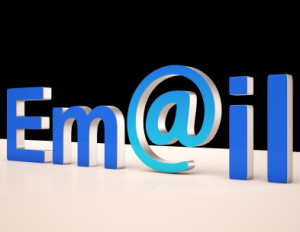by gabriel_sales | Sep 3, 2013
 As a B2B sales tactic, email marketing can still be a highly effective strategy. However, there are good ways and bad ways to send B2B sales emails and things you can do to make your email content marketing more effective. This blog suggests the advantages of sending your B2B sales emails with marketing content from a “Marketing Team/Director.”
As a B2B sales tactic, email marketing can still be a highly effective strategy. However, there are good ways and bad ways to send B2B sales emails and things you can do to make your email content marketing more effective. This blog suggests the advantages of sending your B2B sales emails with marketing content from a “Marketing Team/Director.”
Less Sales-y=Less Threatening
Do you remember walking into the dealership to buy your first car and dreading the moment the car salesman spotted you? The dread you felt comes from a widespread and deep-seated dislike of being sold to. We simply don’t like experiences where we feel like we have no control of the outcome.
By sending your emails with marketing content from “marketing@companyX”, your prospects feel more like you are trying to educate them rather than sell to them—which will put them much more at ease and give them a reason to trust you. Sending emails this way also allows the prospect to educate themselves on your product or solution without feeling like they are obligated to talk to the salesperson later down the road.
Perception is Everything
Another good reason for having B2B marketing content come from your marketing team is with the nature of sales, whether you are doing it in-house or outsourcing it, you aren’t always going to have the same person doing exactly the same thing. For example, you may have someone start off in a cold calling role and then move up to a account management role.
Whenever you have shifts (from an HR perspective), you don’t want to have to keep rewriting emails to change addresses and signatures—making it appear that you are disorganized to your prospects by having emails constantly coming from different people. If all of your content comes from marketing, it makes you appear more organized even as you have people moving from role to role internally.
If you are a smaller company, this strategy can help make you appear larger than you are. You may not have a whole marketing department, but if you have emails coming from “marketing”, along with the right sales and marketing technologies in place to help with automation, no one ever knows that you don’t have 20-30 sales people behind you.
In summary, sending B2B marketing content from your “marketing team” or “marketing director” can help you appear to be less threatening and more organized. Ultimately, your customers will thank you in the form of repeat business if you allow them to dictate when they engage with the sales rep.
If you would like more information on B2B email marketing, click here. If you have any questions, please feel free to contact us.
by Glen Springer | Aug 29, 2013
This is the final part of a four-part Blog series discussing the six “types” or buyer personas of B2B buyers that occupy the digital space. We also offer some practical tips on how to adapt your sales and marketing strategies to make it easier for your buyer.
The third part of this series discussed the buyer personas of the Mystery Man and The Eager Beaver. This blog dives into the Worrywart and the Know-it-all.
 Different Types of Buyer Personas
Different Types of Buyer Personas
The Worrywart
So far, we have talked about the newfound power the B2B has to control the sales process. While this new sense of power gives buyers more confidence they are making the most informed decision they can, there are still those that worry constantly about doing the right thing. And despite the internet’s infinite facts and figures, a web page will never look into your eyes and assure you that you are making the best choice possible. That is what you need to do to sell to the worrywart.
To sell to the worrywart, you need to showcase your humanity. Have pictures and brief bios of your executive staff on your website. Post videos that feature your CEO or top salesmen displaying their industry expertise. The worrywart hates pushy salesmen, so when talking to him, try to show and much transparency and authenticity as possible. Give him the facts and numbers without the sales-y language, and you will give him confidence you aren’t trying to ‘pull a fast one’ on him. Anything you can do to build a personal and honest relationship with the worrywart will help alleviate his fears and give him a reason to trust you.
 The Know-It-All
The Know-It-All
Our last buyer persona is the know-it-all. The know-it-all is a lot like the device queen, only smarter. When she’s looking to make a purchase, she pours over industry reports, white papers and expert reviews. Like the eager beaver, she wants to go through the buying process on her own and only interact with you when it is absolutely imperative. She wants to feel that she reaches any decision she makes on her own—without the persuasion of smooth-talking salesmen.
The trick with selling to the know-it-all is to get out of her way until she comes to you. Let her go through all of your content on her own, but make sure she knows she can call you with any questions. Despite her excellent research skills, there may be something about your service options or value proposition that she is unclear on. This is your salesmen’s chance to demonstrate intelligence and expertise, two things the know-it-all values greatly.
To prepare to sell to her, have your salesmen come up with a list of the most common questions or objections you hear, draft answers and practice them so you can deliver them quickly and confidently. If she asks one of your junior salesmen a question, and he can’t come up with an answer right away, you will never hear from her again. On the other hand, if you are able to convince your know-it-all you are as sharp as she is, she will be convinced she can trust you and will likely give you her business.
So there they are, the six types of B2B buyers or buyer personas you encounter today. While we presented them here as distinct personality types, it is important to remember that your B2B buyer is likely a combination of two or more of these types, so you need to try to sell to all of them simultaneously.
By changing your sales strategy to meet the new demands of post-internet buyers, you can make your prospects feel like you understand them on a personal level. Despite the many changes the internet brought, the bedrock of selling will always be personal relationships, so anything you do to help personalize your sales process is going to help you win.
If you would like more educational content on how integrating insights about your buyers with marketing automation can affect your sales, click here. To learn more about the sales and marketing outsourcing services we offer (including marketing automation implementation, content development and lead nurturing), you can check out our services page. If you are interested in a free review of your sales cycle, you can request one here.
by Glen Springer | Aug 29, 2013
This is the final part of a four-part Blog series discussing the six “types” or buyer personas of B2B buyers that occupy the digital space. We also offer some practical tips on how to adapt your sales and marketing strategies to make it easier for your buyer.
The third part of this series discussed the buyer personas of the Mystery Man and The Eager Beaver. This blog dives into the Worrywart and the Know-it-all.
 The Worrywart
The Worrywart
So far, we have talked about the newfound power the B2B has to control the sales process. While this new sense of power gives buyers more confidence they are making the most informed decision they can, there are still those that worry constantly about doing the right thing. And despite the internet’s infinite facts and figures, a web page will never look into your eyes and assure you that you are making the best choice possible. That is what you need to do to sell to the worrywart.
To sell to the worrywart, you need to showcase your humanity. Have pictures and brief bios of your executive staff on your website. Post videos that feature your CEO or top salesmen displaying their industry expertise. The worrywart hates pushy salesmen, so when talking to him, try to show and much transparency and authenticity as possible. Give him the facts and numbers without the sales-y language, and you will give him confidence you aren’t trying to ‘pull a fast one’ on him. Anything you can do to build a personal and honest relationship with the worrywart will help alleviate his fears and give him a reason to trust you.
 The Know-It-All
The Know-It-All
Our last buyer persona is the know-it-all. The know-it-all is a lot like the device queen, only smarter. When she’s looking to make a purchase, she pours over industry reports, white papers and expert reviews. Like the eager beaver, she wants to go through the buying process on her own and only interact with you when it is absolutely imperative. She wants to feel that she reaches any decision she makes on her own—without the persuasion of smooth-talking salesmen.
The trick with selling to the know-it-all is to get out of her way until she comes to you. Let her go through all of your content on her own, but make sure she knows she can call you with any questions. Despite her excellent research skills, there may be something about your service options or value proposition that she is unclear on. This is your salesmen’s chance to demonstrate intelligence and expertise, two things the know-it-all values greatly.
To prepare to sell to her, have your salesmen come up with a list of the most common questions or objections you hear, draft answers and practice them so you can deliver them quickly and confidently. If she asks one of your junior salesmen a question, and he can’t come up with an answer right away, you will never hear from her again. On the other hand, if you are able to convince your know-it-all you are as sharp as she is, she will be convinced she can trust you and will likely give you her business.
So there they are, the six types of B2B buyers or buyer personas you encounter today. While we presented them here as distinct personality types, it is important to remember that your B2B buyer is likely a combination of two or more of these types, so you need to try to sell to all of them simultaneously.
By changing your sales strategy to meet the new demands of post-internet buyers, you can make your prospects feel like you understand them on a personal level. Despite the many changes the internet brought, the bedrock of selling will always be personal relationships, so anything you do to help personalize your sales process is going to help you win.
If you would like more educational content on how integrating insights about your buyers with marketing automation can affect your sales, click here. To learn more about the sales and marketing outsourcing services we offer (including marketing automation implementation, content development and lead nurturing), you can check out our services page. If you are interested in a free review of your sales cycle, you can request one here.
by Glen Springer | Aug 28, 2013
This is part three of a four-part Blog series discussing the six “types” or buyer personas of B2B buyers that occupy the digital space. We also offer some practical tips on how to adapt your sales and marketing strategies to make it easier for your buyer.
The second part of this blog series discussed the buyer personas of the Window Shopper and The Device Queen. This blog dives into the Mystery Man and the Eager Beaver.
 Different Types of Buyer Persona
Different Types of Buyer Persona
The Mystery Man
Our next buyer is the mystery man. To me, he’s like the popular guy in high school. You never know what we wants, what he’s doing, or if he’s ever going to call you again. He seems like he’s interested, but you never know how many of your competitors he’s talking to at the same time. The mystery man may call you three times in a week or spend a night reading every blog you’ve ever written, only to disappear into digital oblivion for the next six months, or forever.
To be honest, if you don’t have a marketing automation platform, you don’t really have any hope of selling to the mystery man buyer persona. Because his aloof, “I-do-what-I-want-when-I-want” attitude is baffling to a sales team who expects a linear progression from discovery to close, marketing has to step in to explain what’s happening behind the scenes.
Your mystery man could actually be a team of mystery men from the same company, each member having stake in the buying decision and educating themselves separately over the course of a few months. Or, your mystery man may be doing early stage research for a purchase he plans to make a year from now. Or, he could be workaholic from your own industry trying to get an edge on the competition.
In any of these situations, a marketing automation platform will help you identify who you are interacting with and track digital engagement over time—giving you and your sales team more visibility into who to sell to and when to sell. Once a prospect shows up in your marketing automation platform, they will stay there as long as you want. That way, you will know the second a cold lead from six months ago has revisited your content, and you can pick up where you left off.
 The Eager Beaver
The Eager Beaver
The next type of buyer grew up with graphing calculators and spellcheck—meaning his need for instant gratification in regards to information was hardwired from childhood. This need for instant gratification has only increased in recent years with faster internet speeds and more powerful search engines, and if you aren’t able to deliver on this demand, you’ll be left in the dust.
The motto of the eager beaver is, “Just let me do it myself. Now!” He is independent and impatient and does not want to have to wait for you to respond to his email. In other words, he wants to learn everything there is to know about your company without personally interacting with you. And if you want to sell to him, you need to give him what he wants.
To sell to the eager beaver, every aspect of your sales script needs to be replicated into a digital format and posted where it can be easily found. This means you need general “About Us” and “Services” pages to help people get to know you in addition to more specific product or service info that will help those further along in the buying cycle. You basically need to create a do-it-yourself, digital version of the process your top salesman goes through with each prospect. For example, if your salesman takes your prospects through a product or software demo before closing, then record the demo and publish on a landing page, so it can be accessible anytime.
You can still have requirements to download or access your high-value content in order to track buyer intent, just remember that “too many download requirements” is the number one annoyance of B2B buyers today.
For the last part of this blog series profiling the final two buyer personas, click here.
One of the top advantages of Marketing Automation is the ability to help your sales rep understand how to best sell to this buyer. If you would like more educational content on how integrating insights about your buyers with marketing automation can affect your sales, click here.
To learn more about the sales and marketing outsourcing services we offer (including marketing automation implementation, content development and lead nurturing), you can check out our services page. If you are interested in a free review of your sales cycle, you can request one here.
by Glen Springer | Aug 28, 2013
This is part three of a four-part Blog series discussing the six “types” or buyer personas of B2B buyers that occupy the digital space. We also offer some practical tips on how to adapt your sales and marketing strategies to make it easier for your buyer.
The second part of this blog series discussed the buyer personas of the Window Shopper and The Device Queen. This blog dives into the Mystery Man and the Eager Beaver.
 The Mystery Man
The Mystery Man
Our next buyer is the mystery man. To me, he’s like the popular guy in high school. You never know what we wants, what he’s doing, or if he’s ever going to call you again. He seems like he’s interested, but you never know how many of your competitors he’s talking to at the same time. The mystery man may call you three times in a week or spend a night reading every blog you’ve ever written, only to disappear into digital oblivion for the next six months, or forever.
To be honest, if you don’t have a marketing automation platform, you don’t really have any hope of selling to the mystery man. Because his aloof, “I-do-what-I-want-when-I-want” attitude is baffling to a sales team who expects a linear progression from discovery to close, marketing has to step in to explain what’s happening behind the scenes.
Your mystery man could actually be a team of mystery men from the same company, each member having stake in the buying decision and educating themselves separately over the course of a few months. Or, your mystery man may be doing early stage research for a purchase he plans to make a year from now. Or, he could be workaholic from your own industry trying to get an edge on the competition.
In any of these situations, a marketing automation platform will help you identify who you are interacting with and track digital engagement over time—giving you and your sales team more visibility into who to sell to and when to sell. Once a prospect shows up in your marketing automation platform, they will stay there as long as you want. That way, you will know the second a cold lead from six months ago has revisited your content, and you can pick up where you left off.
 The Eager Beaver
The Eager Beaver
The next type of buyer grew up with graphing calculators and spellcheck—meaning his need for instant gratification in regards to information was hardwired from childhood. This need for instant gratification has only increased in recent years with faster internet speeds and more powerful search engines, and if you aren’t able to deliver on this demand, you’ll be left in the dust.
The motto of the eager beaver is, “Just let me do it myself. Now!” He is independent and impatient and does not want to have to wait for you to respond to his email. In other words, he wants to learn everything there is to know about your company without personally interacting with you. And if you want to sell to him, you need to give him what he wants.
To sell to the eager beaver, every aspect of your sales script needs to be replicated into a digital format and posted where it can be easily found. This means you need general “About Us” and “Services” pages to help people get to know you in addition to more specific product or service info that will help those further along in the buying cycle. You basically need to create a do-it-yourself, digital version of the process your top salesman goes through with each prospect. For example, if your salesman takes your prospects through a product or software demo before closing, then record the demo and publish on a landing page, so it can be accessible anytime.
You can still have requirements to download or access your high-value content in order to track buyer intent, just remember that “too many download requirements” is the number one annoyance of B2B buyers today.
For the last part of this blog series profiling the final two buyer personas, click here.
One of the top advantages of Marketing Automation is the ability to help your sales rep understand how to best sell to this buyer. If you would like more educational content on how integrating insights about your buyers with marketing automation can affect your sales, click here.
To learn more about the sales and marketing outsourcing services we offer (including marketing automation implementation, content development and lead nurturing), you can check out our services page. If you are interested in a free review of your sales cycle, you can request one here.
by Glen Springer | Aug 27, 2013
This is part two of a four-part blog series discussing the six “types” or buyer personas of B2B buyers that occupy the digital space. We also offer some practical tips on how to adapt your sales and marketing strategies to make it easier for your buyer.
Part one of this blog series talked about how buyers have changed dramatically with the increased capabilities and use of the internet and web-based technologies. We will now look at the six new buyer types or buyer personas in the B2B space today.
 The Window Shopper
The Window Shopper
The first type of buyer persona thrives in the freedom inherent to the internet. She is spontaneous, flexible, impulsive and easily distracted. Unlike her pre-internet predecessor who had to methodically preplan B2B purchases using limited resources, today’s B2B buyer can float in and out of the buying cycle as she chooses.
No longer inhibited by a temporally structured and linear buying cycle with a predetermined result, the window shopper can take herself through the buying cycle at her own pace. She may see something she cannot live without and buy almost immediately. Or, she may take her team through nearly the entire sales process and then get distracted by a more pressing business issue.
The flighty and spontaneous nature of the window shopper can be frustrating for B2B salesmen trying to build momentum toward a sale. The important thing to remember when selling to a window shopper is that even though she may not be following the normal timeline of your buying process, there are still certain stages she needs to move through (pain, discovery, evaluation of alternatives, purchase, repurchase).
This is a situation where marketing automation can be of great value. By creating digital content to match each stage of the buying process and then monitoring engagement with that content using marketing automation, you can intuitively understand where each prospect is in the buying cycle, despite the unpredictable timeline. Once you understand more about where each prospect is at, you can try to guide the window shopper’s impulses to the next stage by creating a sense of importance in your marketing content to accelerate the purchase.
 The Device Queen
The Device Queen
The next type of buyer is the uber-connected technology addict. She has a MacBook, a desktop, an iPhone, a Kindle and an iPad. She has apps set up on all of them to give her instant updates on the things she’s interested in. She’s tweeted twice and read three blog posts since I started writing this paragraph.
In the digital space, you’ll find the device queen everywhere. She’ll be on a mobile app one moment and her desktop the next, going wherever her next whim takes her. In order to sell to this person, you need to be everywhere she is. This means you need to be able to engage with her on her phone, computers and tablets.
The first step in doing this is making sure all of your marketing content is compatible with mobile devices. While it may not make sense to invest in building your own mobile app, it is pretty simple to make sure your graphics, videos and text are in formats that can be easily viewed on all mobile devices. The second step in engaging with a device queen is to offer many different options for consuming the same content. Sometimes she will feel like watching a 30-minute webcast on her desktop, but other times she would rather have a quick, mobile summary in 140 characters or less. Offer her both, and then make sure she can find the information on search engines as easily as possible through intelligent SEO optimization.
For the next part of this blog series profiling the second two buyer personas, click here.
If you would like more educational content on how integrating insights about your buyers with marketing automation can affect your sales, click here. To learn more about the sales and marketing outsourcing services we offer (including marketing automation implementation, content development and lead nurturing), you can check out our services page. If you are interested in a free review of your sales cycle, you can request one here.
 As a B2B sales tactic, email marketing can still be a highly effective strategy. However, there are good ways and bad ways to send B2B sales emails and things you can do to make your email content marketing more effective. This blog suggests the advantages of sending your B2B sales emails with marketing content from a “Marketing Team/Director.”
As a B2B sales tactic, email marketing can still be a highly effective strategy. However, there are good ways and bad ways to send B2B sales emails and things you can do to make your email content marketing more effective. This blog suggests the advantages of sending your B2B sales emails with marketing content from a “Marketing Team/Director.”










